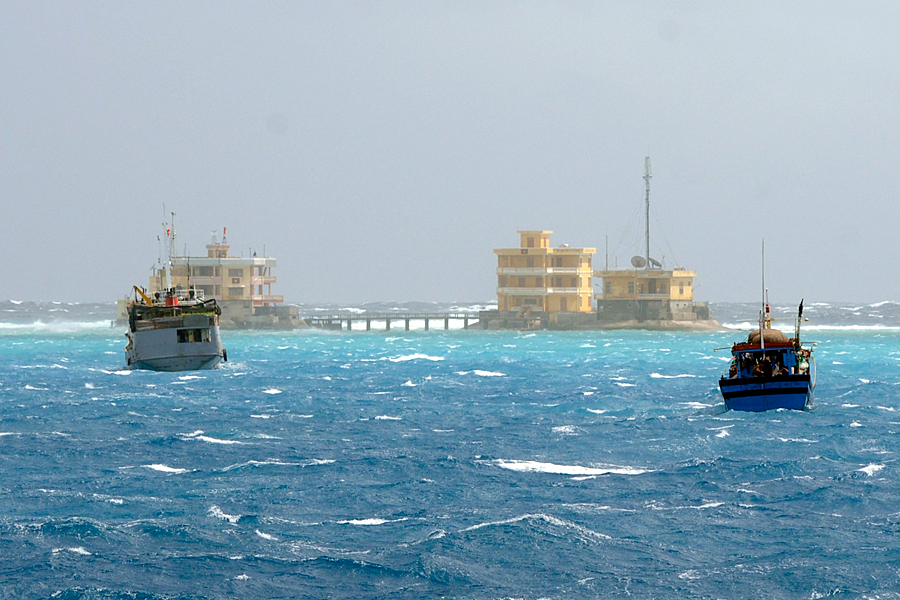Pixel by pixel, Taiwan maps out claims to contested South China Sea
Loading...
| Taipei, Taiwan
Wang Cheng-gi laughs nervously as he discusses the detailed new maps of the disputed South China Sea being drawn in his corner office at Taiwan’s Department of Land Administration.
He’s skittish because results of the $2.98 million project to map out the minutia of every islet in the resource-rich ocean south of Taiwan are still classified. But when completed in about a year, the maps could reshape Taiwan’s often-overlooked maritime claim against more powerful Asian governments.
Seven countries lay claim to parts of the South China Sea, the strategic waters through which 50 percent of the world's shipping tonnage passes, and under which vast deposits of oil and gas may lie. Taiwan is pushing its first-ever mapping project to back up its own claims – which are as large as mainland China's – and to be one step ahead in the knowledge game of who is doing what in the contested waters.
High-resolution images
Mr. Wang’s desktop computer receives high-resolution images taken by two American-made satellites and beamed back to a private contractor. Five people on his staff use them to compile maps that they hope rival governments, including China, don’t yet have.
“The satellite images will let our government departments see the latest situations and understand which country is doing what,” says Wang, a senior specialist overseeing the five-year project. “We might find things we’ve not seen before.”
One surprise to Wang so far is the activity of Vietnam, which is developing reefs and artificial islands in the Spratly Island, the largest South China Sea archipelago that Taiwan also claims. Hanoi has landfilled shallow reefs and built homes on some islets, according to images that can be blown up to about a square meter per islet.
“It’s really clear,” Wang says. One Vietnamese landfill project spans 11 football fields, he says. “Everyone is talking about mainland China, but Vietnam is going all out.
“This year they’ve landfilled to here, but maybe next year they will fill out to there,” he says, pointing to spots on a handbill-sized map of the full ocean that he’s allowed to print out for discussion purposes.
Taiwan has extra reason to be sensitive toward Vietnam. In May, Vietnamese and Chinese vessels stood-off at sea after Beijing moved an oil rig into waters claimed by both countries. When 20,000 Vietnamese protested over the face-off, Taiwan was also drawn in – several of its factories were looted and burned, perhaps because they were mistaken for Chinese factories.
Large claims
Taiwan controls just two of the South China Sea’s hundreds of islets: the largest, 114-acre Itu Aba, and one of the dunes, which is too unstable for human occupation. Taiwan’s limited presence in the ocean has set back hopes of competing for undersea reserves that the US Energy Information Administration estimates at 11 billion barrels of oil and 190 trillion cubic feet of natural gas.
Taipei is gathering evidence to be taken seriously when it reiterates claims to the South China Sea, analysts say. Taiwan would otherwise be forgotten as a claimant, reducing future access to the less developed islets or resources at sea.
“We do not have the resources and manpower and firepower to sustain [our claims],” says Alexander Huang, strategic studies professor with Tamkang University in Taiwan. The maps, he says, will give Taiwan “more evidence” of its claim and show that “we’re not shying away from this issue.”
Taiwan lays the same vast claims to the South China Sea that Beijing does. Both governments use the same perimeter – the so-called "nine-dash" line – to claim most of the sea's tiny islets. But Taiwan’s government, officially known as the Republic of China, says it laid the claim first, around 1947 after Japanese troops lost World War II and before Communist China was founded.
Taiwan has been self-ruled since the Republic of China government lost the Chinese mainland to the Communists in the Chinese civil war in the 1940s and rebased in Taipei. Beijing claims sovereignty over Taiwan and its offshore territory, causing tension between the two sides and cutting Taiwan out of any regional maritime dialogue, as other governments recognize only the much larger China diplomatically.
Unwelcome in Asia?
The maps, Taiwan’s best at a scale of 1:5,000, could be a valuable intelligence asset. Scholars in Washington will welcome Taiwan’s maps as they look to democratic Taipei for details on China’s basis for claiming the sea, Mr. Huang says.
The United States has criticized China’s expansion in the sea, offered defense aid to the Philippines, and begun considering whether to lift a wartime ban on selling deadly weapons to Vietnam.
But Taiwan’s new gambit to revive its South China Sea claims would be less welcomed around Asia. The Philippines, which has extensive fisheries but little physical presence in the disputed ocean, is already asking the UN Convention on the Law of the Sea to review the basis for China’s claim. If the UN sided with the Philippines against China, Manila would have grounds to dispute Taiwan, as well.
“Taiwan should be aware of the UN Convention because that impacts its own claims,” warns Ramon Casiple, a blogger and political analyst in the Philippines.
Analysts expect Taiwan to follow up its maps at least by adding infrastructure to Itu Aba. It operates an airstrip there now and expects to finish a pier next year to accommodate naval and coast guard vessels. Vietnam has already voiced opposition.
“I think [Taiwan] is worried that other countries are claiming sovereignty in that area and if you don’t do something, you’re going to be left out,” says Shane Lee, an international relations professor at Chang Jung Christian University in Taiwan.






